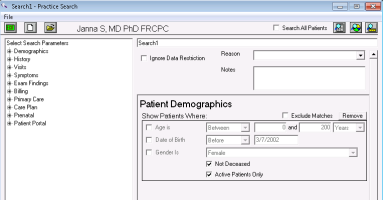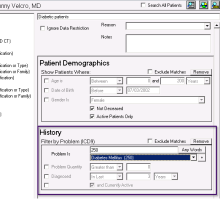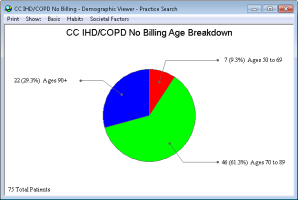Creating new practice searches
Before you can perform a search that produces a patient list or create a rule to flag patients who have a specific condition, you must first create a practice search. A practice search defines what parameters patients must meet to appear on a search report or to be flagged by a rule.
When creating billing-related searches, you can use the eligibility criteria set by the GPSC to define appropriate parameter. For example, you can create practice searches for:
Complex care patients who have been billed with a diagnosis code of H250, and have not been billed for a 14033 in over 1 year.
Chronic disease patients who have a diagnosis of Diabetes (250, or any variant such as 250.1) in their problem list, and have not been billed for a 14050 in over 1 year.
When creating practice searches, patients must match ALL parameters. You cannot set a group of parameters where patients need to match only one parameter. For example, for a diabetic practice search you cannot find patients that have:
An ICD9 diagnosis code of 250 in the problem list, OR
Have had a Hemoglobin A1C value > 6.5, OR
Have been billed for the diagnosis code of 250
Ensure all patients who are chronic disease or complex care patients have the correct problem code in their problem list. This way, you can search for those patients using only one parameter. See Entering consistent data for CDM.
Steps
| 1. | From the Wolf EMR home page, click Practice Search |
| 2. | Click Make a New Search |
| 3. | When prompted to clear the current search, click Yes. |
| 4. | In the top field, type a descriptive name for your search. |
| 5. | Enter a search parameter: |
| a) | In the Select Search Parameters list, expand the appropriate parameter category (such as History). |
| b) | In the expanded list, click the parameter you want (such as Problem (ICD9)). The EMR displays a new area for the parameter on the right side of the window. |
For chronic disease management practice searches, you typically search for patients based on Problem (ICD9). If you select an ICD9 code without a decimal (such as 250), the search includes all decimal points for that number (such as 250.1).
Most parameters based on medical summary information (such as Problem, Lab Results, and documents) are available in the History category.
Parameters based on patient last and next appointments (Last Visit, and Next Visit) are available in the Demographics category.
| c) | In the parameter area, enter the parameter details. |
| 6. | Repeat to add additional parameters. |
| 7. | If you want to exclude patients that match the parameter you create, select the Exclude Matches check box. |
| 8. | To remove a parameter, in the parameter area on the right side of the window, click Remove. |
| 9. | When you are done, click Save Current Search |
| 10. | Perform one of the following actions: |
To define the practice search as a rule, enter properties for the rule, and then click Save as New. See Creating practice search rules.
To define the practice search as a search that produces a patient list, click Save as New. You can now perform the search.
Once you save a practice search as a search (that is, you save it without selecting the Save Item as Rule check box), you cannot later change the search to a rule.
| 11. | To display a list of patients who match the criteria, click Show Search Results as a Patient List |
| 12. | To show the search results as a pie chart broken down by various demographic factors, click Show Search Results in the Demographic Viewer |
Use the menus at the top (Basic, Habits, Societal Factors) to change the demographic factors.
Double-click a pie slice to see the patient list.
| 13. | To run all of the rules within the practice search, click Execute the Rule Engine . For more information, see Practice search rules |
Tip: You can manually run a rule (that is, produce a list of rule matches) at any time. In the Open Saved Search or Rule window, select the rule you want to run, and then click Open Selected. In the Practice Search window, click Execute the Rule Engine ![]() .
.
When you execute a rule, it can take a long time to complete, and as the rule is being executed, Wolf EMR may slow down for you and other clinic users. For this reason, it is recommended that you execute rules after clinic hours.
| 14. | To save your practice search for later reuse, click |
You are now ready to run your search. See Performing practice searches.
© 2018 


